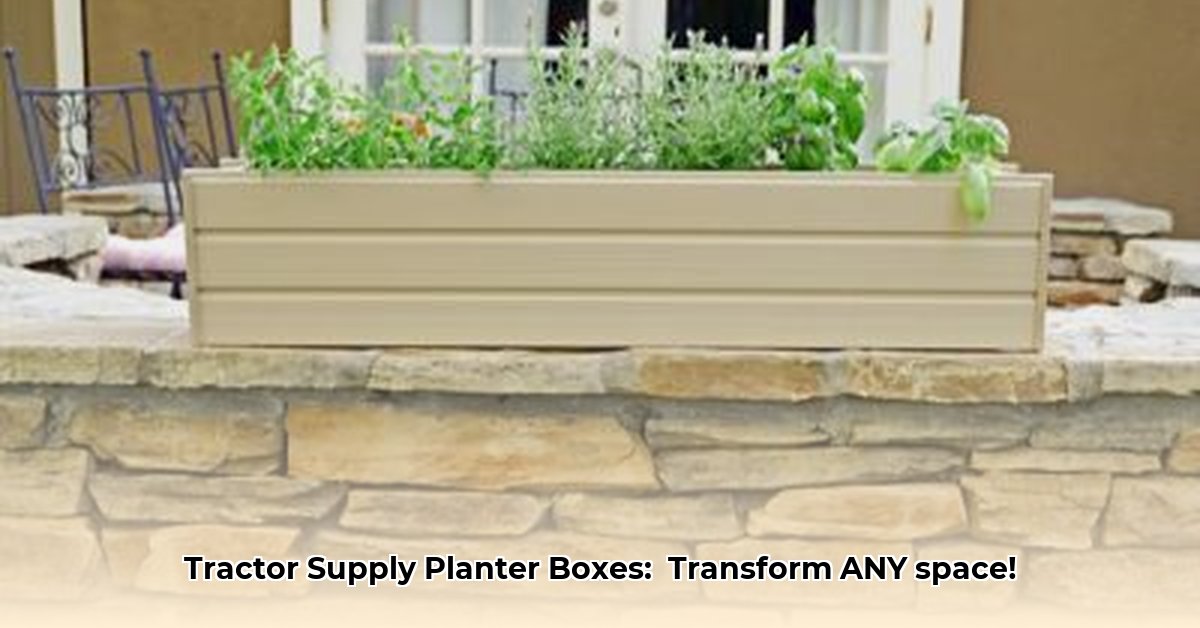
Choosing the Right Planter Box from Tractor Supply: A Comprehensive Guide
Ready to cultivate your dream garden, but short on space or lacking traditional garden beds? Planter boxes offer a fantastic solution, and Tractor Supply provides a diverse range of options to suit various needs and budgets. This guide helps you select, assemble, and maintain the perfect planter box for your gardening aspirations. Did you know that using planter boxes can increase your garden's yield by up to 25% compared to in-ground planting, thanks to improved soil drainage and sun exposure? (Source: University of Minnesota Extension)
For more options, check out these Tractor Supply bushel baskets.
Choosing the ideal planter box hinges on three key factors: available space, budget, and the types of plants you intend to grow. A small balcony might necessitate a compact, shallow planter, while a spacious yard opens up possibilities for larger, more elaborate raised beds. Budget considerations influence material choices: durable wooden boxes offer classic charm, while plastic or metal options prioritize convenience and lower maintenance. Regardless of your selection, prioritizing good drainage is crucial – poor drainage commonly leads to root rot, hindering plant health.
Popular Planter Box Options at Tractor Supply
Tractor Supply stocks a variety of planter boxes. The following table compares popular choices, aiding your decision-making process:
| Planter Box Type | Material | Size Options | Ideal Plants | Advantages | Disadvantages |
|---|---|---|---|---|---|
| Raised Garden Bed | Treated Wood | Small to Extra-Large | Vegetables, Herbs, Flowers | Sturdy, long-lasting, excellent drainage | Requires assembly, may need periodic maintenance |
| Plastic Planter Box | Plastic | Small to Large | Flowers, Herbs, Small Vegetables | Lightweight, easy to move, simple to clean | Can fade in sunlight, may not offer aesthetic appeal |
| Metal Planter Box | Galvanized Steel | Small to Large | Vegetables, Flowers | Rust-resistant, durable, modern style | Can overheat in direct sunlight |
Remember, the planter box's size directly affects plant health and growth. Choosing a size appropriate for your plants' mature dimensions prevents overcrowding, ensuring optimal growth and preventing stunted development.
Assembling and Maintaining Your Tractor Supply Planter Box: A Step-by-Step Guide
Assembling your new planter box is typically straightforward. While manufacturer instructions are usually included, this general guide provides supplementary assistance:
Gather Your Tools: You will need a screwdriver, measuring tape, level (for even placement), and work gloves.
Site Selection: Choose a sunny, level location, considering your plants' sunlight requirements.
Assembly: Carefully follow the manufacturer's instructions, taking your time to ensure accuracy.
Drainage (If Necessary): Many planter boxes require drainage holes. If yours lacks them, carefully drill holes to prevent waterlogging. This crucial step minimizes the risk of root rot.
Soil Preparation: Use a high-quality potting mix formulated for containers, not garden soil, to optimize drainage.
Planting: Space seedlings according to their specific needs, referring to plant tags or seed packets for spacing guidance.
Initial Watering: After planting, thoroughly water to settle the soil.
Long-Term Planter Box Care: Simple Maintenance Tips
Regular maintenance maximizes the lifespan and aesthetic appeal of your planter boxes. Follow these simple steps:
Cleaning: Regularly remove weeds and dead leaves. Periodic rinsing keeps your planter box clean and prevents pest infestation.
Damage Assessment: Inspect regularly for cracks or damage. Addressing minor issues promptly prevents them from escalating.
Repotting: As plants grow, they may need larger containers. Repotting ensures adequate root space for healthy growth.
Winterization (If Applicable): In colder climates, empty and clean boxes before winter, storing them properly protects them from the elements.
Choosing the right planter box from Tractor Supply is a pivotal step towards a thriving garden. By considering your space, budget, plant selection and employing these simple maintenance tips, you will be well on your way to enjoying a beautiful garden.